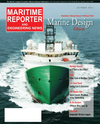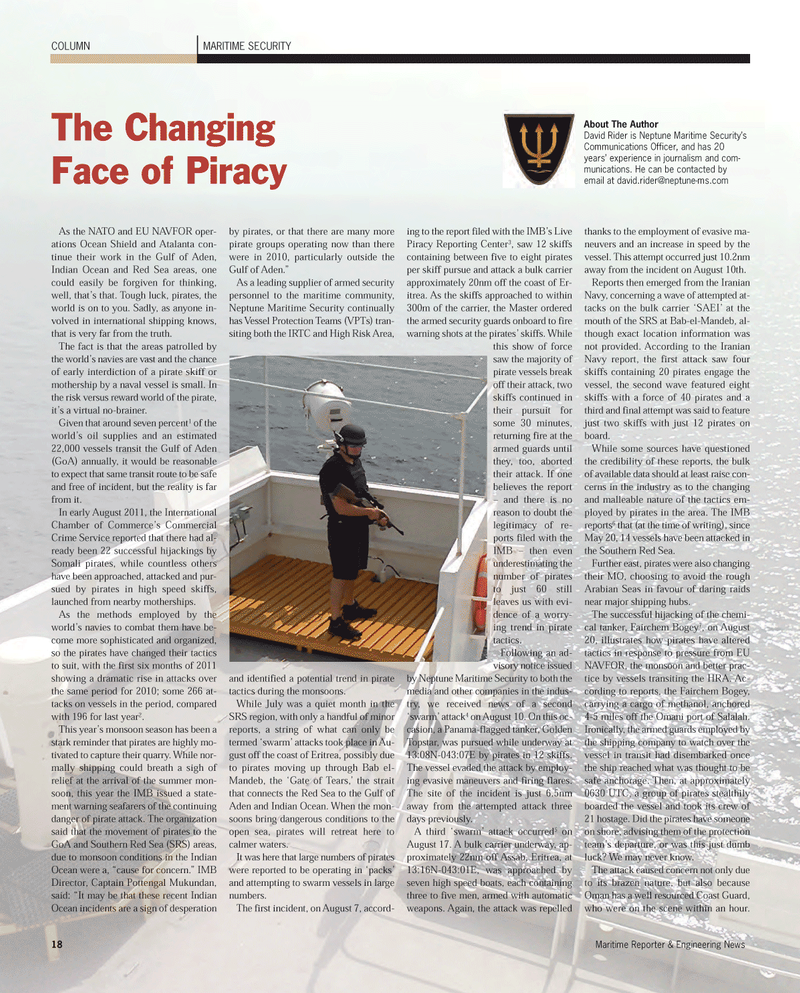
Page 18: of Maritime Reporter Magazine (October 2011)
Marine Design Annual
Read this page in Pdf, Flash or Html5 edition of October 2011 Maritime Reporter Magazine
18Maritime Reporter & Engineering News As the NATO and EU NAVFOR oper- ations Ocean Shield and Atalanta con- tinue their work in the Gulf of Aden, Indian Ocean and Red Sea areas, onecould easily be forgiven for thinking, well, that?s that. Tough luck, pirates, the world is on to you. Sadly, as anyone in- volved in international shipping knows, that is very far from the truth. The fact is that the areas patrolled by the world?s navies are vast and the chance of early interdiction of a pirate skiff or mothership by a naval vessel is small. In the risk versus reward world of the pirate, it?s a virtual no-brainer. Given that around seven percent 1of theworld?s oil supplies and an estimated 22,000 vessels transit the Gulf of Aden (GoA) annually, it would be reasonable to expect that same transit route to be safe and free of incident, but the reality is far from it. In early August 2011, the International Chamber of Commerce?s Commercial Crime Service reported that there had al-ready been 22 successful hijackings bySomali pirates, while countless othershave been approached, attacked and pur- sued by pirates in high speed skiffs, launched from nearby motherships.As the methods employed by the world?s navies to combat them have be- come more sophisticated and organized, so the pirates have changed their tactics to suit, with the first six months of 2011 showing a dramatic rise in attacks over the same period for 2010; some 266 at-tacks on vessels in the period, compared with 196 for last year2.This year?s monsoon season has been a stark reminder that pirates are highly mo-tivated to capture their quarry. While nor- mally shipping could breath a sigh ofrelief at the arrival of the summer mon- soon, this year the IMB issued a state-ment warning seafarers of the continuing danger of pirate attack. The organization said that the movement of pirates to the GoA and Southern Red Sea (SRS) areas,due to monsoon conditions in the IndianOcean were a, ?cause for concern.? IMB Director, Captain Pottengal Mukundan, said: ?It may be that these recent IndianOcean incidents are a sign of desperationby pirates, or that there are many more pirate groups operating now than there were in 2010, particularly outside theGulf of Aden.? As a leading supplier of armed securitypersonnel to the maritime community, Neptune Maritime Security continuallyhas Vessel Protection Teams (VPTs) tran- siting both the IRTC and High Risk Area, and identified a potential trend in pirate tactics during the monsoons. While July was a quiet month in the SRS region, with only a handful of minor reports, a string of what can only betermed ?swarm? attacks took place in Au- gust off the coast of Eritrea, possibly due to pirates moving up through Bab el- Mandeb, the ?Gate of Tears,? the strait that connects the Red Sea to the Gulf ofAden and Indian Ocean. When the mon- soons bring dangerous conditions to theopen sea, pirates will retreat here tocalmer waters. It was here that large numbers of pirates were reported to be operating in ?packs?and attempting to swarm vessels in large numbers. The first incident, on August 7, accord- ing to the report filed with the IMB?s Live Piracy Reporting Center 3, saw 12 skiffs containing between five to eight pirates per skiff pursue and attack a bulk carrier approximately 20nm off the coast of Er- itrea. As the skiffs approached to within 300m of the carrier, the Master ordered the armed security guards onboard to fire warning shots at the pirates? skiffs. While this show of force saw the majority of pirate vessels break off their attack, two skiffs continued in their pursuit forsome 30 minutes,returning fire at the armed guards untilthey, too, aborted their attack. If onebelieves the report ? and there is noreason to doubt thelegitimacy of re- ports filed with the IMB ? then even underestimating thenumber of piratesto just 60 stillleaves us with evi- dence of a worry- ing trend in piratetactics.Following an ad- visory notice issuedby Neptune Maritime Security to both themedia and other companies in the indus-try, we received news of a second ?swarm? attack 4on August 10. On this oc- casion, a Panama-flagged tanker, Golden Topstar, was pursued while underway at 13:08N-043:07E by pirates in 12 skiffs. The vessel evaded the attack by employ- ing evasive maneuvers and firing flares. The site of the incident is just 6.5nmaway from the attempted attack three days previously. A third ?swarm? attack occurred 5onAugust 17. A bulk carrier underway, ap- proximately 22nm off Assab, Eritrea, at 13:16N-043:01E, was approached by seven high speed boats, each containing three to five men, armed with automatic weapons. Again, the attack was repelled thanks to the employment of evasive ma- neuvers and an increase in speed by the vessel. This attempt occurred just 10.2nm away from the incident on August 10th. Reports then emerged from the Iranian Navy, concerning a wave of attempted at- tacks on the bulk carrier ?SAEI? at the mouth of the SRS at Bab-el-Mandeb, al-though exact location information was not provided. According to the Iranian Navy report, the first attack saw four skiffs containing 20 pirates engage the vessel, the second wave featured eight skiffs with a force of 40 pirates and a third and final attempt was said to feature just two skiffs with just 12 pirates on board. While some sources have questioned the credibility of these reports, the bulk of available data should at least raise con- cerns in the industry as to the changingand malleable nature of the tactics em-ployed by pirates in the area. The IMB reports6that (at the time of writing), sinceMay 20, 14 vessels have been attacked in the Southern Red Sea. Further east, pirates were also changingtheir MO, choosing to avoid the rough Arabian Seas in favour of daring raids near major shipping hubs. The successful hijacking of the chemi-cal tanker, Fairchem Bogey 7, on August 20, illustrates how pirates have altered tactics in response to pressure from EUNAVFOR, the monsoon and better prac- tice by vessels transiting the HRA. Ac- cording to reports, the Fairchem Bogey, carrying a cargo of methanol, anchored 4-5 miles off the Omani port of Salalah. Ironically, the armed guards employed by the shipping company to watch over the vessel in transit had disembarked once the ship reached what was thought to be safe anchorage. Then, at approximately 0630 UTC, a group of pirates stealthilyboarded the vessel and took its crew of 21 hostage. Did the pirates have someone on shore, advising them of the protectionteam?s departure, or was this just dumb luck? We may never know. The attack caused concern not only dueto its brazen nature, but also because Oman has a well resourced Coast Guard,who were on the scene within an hour. MARITIME SECURITYCOLUMNThe Changing Face of PiracyAbout The AuthorDavid Rider is Neptune Maritime Security?s Communications Officer, and has 20 years? experience in journalism and com-munications. He can be contacted byemail at [email protected] Oct.11 # 3 (18-24):MR Template 10/5/2011 12:36 PM Page 18

 17
17

 19
19
